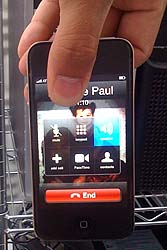First Impressions: iPhone 4
I did not expect to be posting this before my personal iPhone 4 arrived, but my friend Keith showed up with his shiny-new iPhone 4. We did a quick test in my office; this is not an exhaustive test, but it's a start.
First, we placed a call to Paul, another iPhone 4 user. We were going to invoke FaceTime, but I realized that our firewall was too tight - FaceTime requires some ports opened. We'll play with that another time.

The Two-Finger Suspension GripWhile on a live call, we held the phone from the top, and observed five bars. Then, I asked Keith to give the phone a two-handed Grip of Death. After a delay of perhaps fifteen seconds, the signal strength fell to one bar. Regardless of how we applied the Grip of Death, we could not cause the call to drop. I realize this says more about my local signal strength than it does about the phone.
Then, we used electrical tape (white) and wrapped the "band" on the lower half of the phone. Then we repeated the test, again with a live call. The results were identical. There was no discernable difference when we used tape.
Finally, we repeated the test with my Primordial iPhone (a first generation model), and got the same results, except instead of five bars, we started with four bars. Do I think that difference was significant - no, I do not. We still have no idea what the bars mean, especially in the different models.
We did not spend a lot of time, mostly because we were heading for a sushi lunch, but I did draw a couple of preliminary conclusions:
1) The iPhone 4 is not nearly as hypersensitive to "hand" effects as I was being led to believe from the media buzz.
2) The iPhone 4 seems to be as sensitive to hand effects as the Primordial iPhone.
3) Electrical tape over the "band" did nothing.

The Two-Handed Grip of DeathI had predicted in a previous blog posting that the application of electrical tape would not do much, and nothing in this first test implies otherwise. I was frankly surprised that the Grip of Death did not affect the iPhone 4 any more than the primordial iPhone. I was quoted in the press as saying that we're "making a mountain out of a molehill". It may be truer than I thought.
Today Apple released a letter indicating that they were "stunned" to learn that their signal-bar algorithm is "totally wrong", and has been so since the first iPhone models. According to Apple, it was indicating 2 bars more than it should. Further, AT&T has "recently" suggested a standard, and Apple will issue a software patch so that the signal-bar display will conform to this standard.
I've said it before, but now let me say it slightly differently: the only worthy metric for the quality of the cellphone is frequency of dropped calls when compared with other phones used in the same manner, over time. You cannot tell the difference between a "one-bar" conversation with your mother, and a "five-bar" conversation. (This is not be confused with having a conversation with your mother FROM a bar, which I don't recommend.) The only way to observe dropped calls is to use the phone for a statistically significant amount of time.
So, if you are a Bar Watcher, Apple's letter is going to change your observations. If you are a Dropped Call Counter, it will mean nothing. Bar Watching has no value in my opinion; I think it is a waste of your valuable time. If you have a routine that has you driving/walking/riding the same route every weekday, you probably know where your "holes" are. This is how a Dropped Call Counter is going to make observations. Apple's letter does nothing but divert attention from your valuable observations.
My opinion is that it's good that Apple is conforming to a standard. Beyond that.... it's spin.
More details to follow. I will be receiving my iPhone next week.
